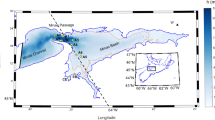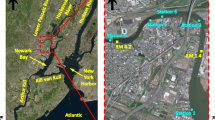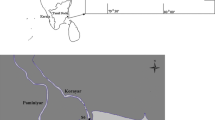Abstract
Suspended solids concentrations were measured at routine 2–3 week intervals and on additional windy days for at least one year in each of seven shallow (mean depth < 2 m) south Island, New Zealand lakes. Surface wave characteristics were estimated from water depths and local meteorological data using a shallow-water wave forecasting model for fetch-limited waves. Bottom shear stresses were computed from surface wave characteristics for the sampling stations and for a hypothetical lake-average station. The calculated shear stresses were, on average, much better predictors of suspended solids concentrations than alternative models using two different functions of wind speed, wave height2/depth or wavelength/depth. A combination of the sample station and lake average shear stresses provided slightly better predictions than the sample station values alone, suggesting that currents also contribute significantly to the concentration at a given point. Regressions of suspended solids on the combined functions had r 2 values ranging from 0.74–0.73 in the seven lakes. The slopes of these regressions were negatively related to the settling velocity of the lowest quartile of the sediment, and to macrophyte biomass, in multiple regression (r 2 = 0.94, p < 0.01).
Similar content being viewed by others
References
Aalderink, R. H., L. Lijklema, J. Breukelman, W. van Raaphorst & A. G. Brinkman, 1984. Quantification of wind induced resuspension in a shallow lake. Wat. Sci. Technol. 17: 903–914.
Barica, J., 1974. Extreme fluctuations in water quality of eutrophic fish kill lakes: effect of sediment mixing.Water Res. 8: 881–888.
Bengtsson, L. & T. Hellström, 1992. Wind resuspension in a small shallow lake. Hydrobiologia 241: 163–172.
Bengtsson, L., T. Hellström & L. Rakoczi, 1990. Redistribution of sediments in three Swedish lakes. Hydrobiologia 192: 167–181.
Bennett, J. R., 1974. On the dynamics of wind-driven lake currents. J. Phys. Oceanogr. 4: 400–414.
Bruton, M. N., 1985. The effect of suspensoids on fish. Hydrobiologia 125: 221–241.
Carper, G. L. & R. W. bachmann, 1984. Wind resuspension of sediments in a prairie lake. Can. J. Fish. Aquat. Sci. 41: 1763–1767.
Cavanié, A. G. 1980. Evaluation of standard error in the estimation of mean and significant wave heights as well as mean period from records of finite length. In: Climatologie de la Mer; Sea Climatology, pp. 73–78. Editions Technip.
CERC, 1973. Shore protection manual, Vol. I. U. S. Army Coastal Eng. Res. Center, Ft. Belvoir, Va.
CERC, 1977. Shore protection manual. Vol. I. U. S. Army Coastal Eng. Res. Center, Ft. Belvoir, Va.
Cole, P. & G. V. Miles, 1983. Two-dimensional model of mud transport. J. Hydraul. Eng., ASCE 109: 1–12.
Dyer, K. R., 1986. Coastal and estuarine sediment dynamics. Wiley: 342 pp.
Einstein, H. A. & R. B. Krone, 1962. Experiments to determine modes of cohesive sediment transport in salt water. J. Geophys. Res. 67: 1451–1461.
Fukuda, M. K. & W. Lick, 1980. The entrainment of cohesive sediments in freshwater. J. Geophys. Res. 85: 2813–1824.
Gerbeaux, P. J., 1989. Aquatic plant decline in Lake Ellesmere. Unpubl. Ph. D. Thesis, Lincoln College, New Zealand: 276 pp.
Gerbeaux, P. J. & J. Ward, 1986. The disappearance of marcrophytes and its importance in the management of shallow lakes in New Zealand. In: Proc. European Weed Res. Soc., 7th Symposium on Aquatic Weeds, pp. 119–124.
Gons, H. J., R. Veeningen & R. van Keulen, 1986. Effects of wind on a shallow lake ecosystem: resuspension of particles in the Loosdrecht Lakes. Hydrobiol. Bull. 20: 109–120.
Håkanson, L., 1977. The influence of wind, fetch and water depth on the sediments in Lake Vånern, Sweden. Can. J. Earth Sci. 14: 397–412.
Håkanson, L>, 1981. On lake bottom dynamics — the energy-topography factor. Can. J. Earth. Sci. 18: 899–909.
Håkanson, L., 1982. Bottom dynamics in lakes. Hydrobiologia 91: 9–22.
Hamilton, D. P., 1990. Sediment resuspension by wind in shallow lakes. Unpubl. Ph. D. thesis. University of Otago, New Zealand: 249 pp.
Hamilton, D. P. & S. F. Mitchell, 1988. Effects of wind on nitrogen, phophorous, and chlorophyll in a shallow New Zealand lake. Verh. Internat. Verein. Limnol. 23: 624–628.
Hawley, N. & B. M. Lesht, 1992. Sediment resuspension in Lake St. Clair. Limnol. Oceanogr. 37: 1720–1737.
Ijima, T. & F. L. W. Tang, 1966. Numerical calculation of wind waves in shallow water. In Proc. 10th Int. Conf. Coastal Eng., ASCE. pp. 38–48. Tokyo.
Irwin, J., 1979.Lake Forsyth bathymetry. N.Z. Oceanographic Inst. Rep., DSIR, N.Z.
Irwin, J., W. Del Main & M. W. Burrows, 1988. Bathymetric survey of Lake Ellesmere. N.Z. Ocenaographic Inst. Rep., DSIR, N.Z.
James, W. F. & J. W. Barko, 1990. Macrophyte influences on the zonation of sediment accretion and composition in a north-temperature reservoir. Arch. Hydrobiol. 120: 129–142.
Jupp, B. P. & D. H. N. Spence, 1977. Limitations on macrophytes in a eutrophic lake, Loch Leven. 2. Wave action, sediments and waterfowl grazing. J. Ecol. 65: 431–436.
Kachel, N. B. & R. W. Sternberg, 1971. Transport of bedload as ripples during an ebb current. Mar Geol. 10: 229–244.
Knowles, C. E., 1982. On the effects of finite depth on wind-wave spectra: 1. A comparison with deep-water equilibrium-range slope and other spectral parameter. J. Phys. Oceanogr. 12: 556–568.
Komar, P. D. & M. C. Miller, 1975. On the comparison between the threshold of sediment motion under waves and unidirectional currents with a discussion of the practical evaluation of the threshold. J. Sed. Petrol. 45: 362–367.
Kristensen, P., M. Søndergaard and E. Jeppesen, 1992. Resuspension in a shallow eutrophic lake. Hydrobiologia. 228: 101–109.
Lam, D. C. L. & J.-M. Jaquet, 1976. Computations of physical transport and regeneration of phosphorous in Lake Erie, fall 1970. J. Fish. Res. Bd. Can. 33: 550–563.
Lavelle, J. W., H. O. Mofjeld & E. T. Baker, 1984. An in situ erosion rate for fine-grained marine sediment. J. Geophys. Res. 89: 6543–6552.
Lick, W., 1982. Entrainment, deposition and transport of fine sediments in lake. Hydrobiologia 91: 31–40.
Livingstone, M. E., B. J. Biggs & J. S. Gifford, 1986. Inventory of New Zealand lakes. Part II, South Island, Water and Soil Publ. 81: 193 pp.
Lonsdale, P. & J. B. Southard, 1974. Experimental erosion of North Pacific red clay. Mar. Geol. 17: M51-M60.
Luettich, R. A., Jr., D. R. F. Harleman & L. Somlyódy, 1990. Dynamic behavior od suspended sediment concentrations in a shallow lake perturbed by episodic wind events. Limnol. Ocenogr. 35: 1050–1067.
McKinnon, S. L. C., 1989. The interrelationship between phytoplankton, submerged macrophytes and black swans (Cygnus atratus) in New Zealand lakes — test of two models, Unpubl. M.Sc. thesis, University of Otago, New Zealand: 74 pp.
McKinnon, S. L. C. & S. F. Mitchell, 1994. Eutrophication and black swan (Cygnus atratus Latham) populations: test of two sample relationships. Hydrobiologia 279–280 (Dev. Hydrobiol. 96): 163–170.
Mehta, A. J., T. M. Parchure, J. G. Dixit & R. Ariathurai, 1982. Resuspension potential of deposited cohesive sediment beds. In V. Kennedy (ed.), Estuarine Comparisons. Academic Press, New York: 591–609.
Mitchell, S. F., 1989. Primary production in a shallow eutrophic lake dominated alternately by phytoplankton and by submerged macrophytes. Aquat. Bot. 33: 101–110.
N.Z. Meteorological Service, 1987. Meterological observations for 1987. Misc. Pub. N.Z. Met. S. 109: 104 pp.
Partheniades, E., 1965. Erosion and deposition of cohesive soils. J. Hydraul. Div., ASCE 91: 105–139.
Phillips, G. L., O. Ominson & B. Moss, 1978. A mechanism to account for macrophyte decline in progressively eutrophicated freshwaters. Aquat. Bot. 4: 103–126.
Scheffer, M., 1990. Multiplicity of stable states in freshwater systems. Hydrobiology 200/201 (Dev. Hydrobiol. 61): 475–486.
Scheffer, M. S. H. Hosper, M.-L. Meijer, B. Moss & E. Jeppesen, 1993. Alternative equilibria in shallow lakes. Trends in Ecology and Evolution 8: 275–279.
Sheng, Y. P., 1979. Modelling sediment transport in a shallow lake. In: P. Hamilton & K. B. Macdonald (eds.), Estuarine and Wetland Processes, pp 299–237. Plenum Press, N. Y.
Sheng, Y. P. & W. Lick, 1979. The transport and resuspension of sediments in a shallow lake. J. Geophys. Res. 84: 1809–1826.
Smith, I.R., 1979. Hydraulic conditions in isothermal lakes. Freshwat. Biol. 9: 119–145.
Somlyódy, L., 1981. Modelling complex environmental system: The Lake Balaton study. WP-81–108, IIASA, Laxenburg, Austria: 14–19.
Somlyódy, L., 1982. Water-quality modelling: a comparison of transport oriented and ecology oriented approaches. Ecol. Modelling 17: 183–207.
Sonlyódy, L., 1986. Wind induced sediment resuspension in shallow lakes. In: Water Quality Modelling in the Inland Natural Environment, pp. 287–298. The Fluid Engineering Centre, England.
Vlag, D. P., 1992. A model for predicting waves and suspended silt concentration in a shallow lake. Hydrobiologia 235/236 (Dev. Hydrobiol. 75): 119–131.
Author information
Authors and Affiliations
Rights and permissions
About this article
Cite this article
Hamilton, D.P., Mitchell, S.F. An empirical model for sediment resuspension in shallow lakes. Hydrobiologia 317, 209–220 (1996). https://doi.org/10.1007/BF00036471
Received:
Revised:
Accepted:
Issue Date:
DOI: https://doi.org/10.1007/BF00036471




